Can you put stainless steel in the dishwasher? This is a question we get asked all the time and it’s not as straightforward as you might think.
The answer to this question depends on what type of stainless steel you’re talking about.
Here are some things to consider if you want to know more about whether or not your particular stainless steel can be washed in a dishwasher:
- What kind of finish does your metal have?
- Does it have a protective coating that needs to be removed before washing?
- Is there any food residue stuck on the surface that would need scrubbing off with soap during the cleaning process?
- Are there any components inside of your appliance that could potentially rust from water?
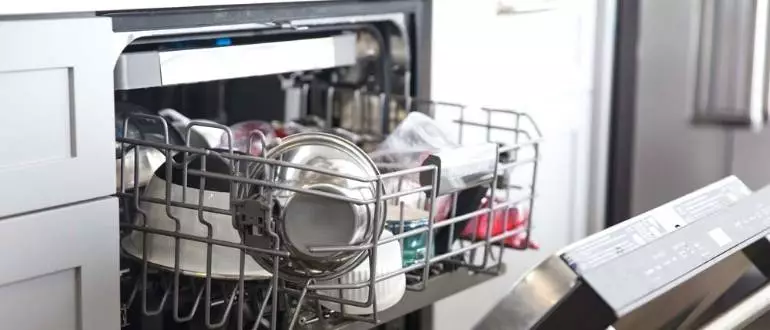
Can you put stainless steel in the dishwasher?
The answer is yes and no, depending on what kind of stainless steel it is.
Yes, you can put silver or polished stainless steel in the dishwasher. If there is nothing stuck on the surface that might need scrubbing off with soap.
If you’re not sure about it, test a small section of your metal first before cleaning the entire thing. It’s better to be safe than sorry.
No, you cannot put brushed stainless steel in the dishwasher. The surface of brushed metal is intended to be hard to the touch.
So that’s why it’s difficult for anything to get stuck on it. It has no protective coating and can rust if left in water for too long.
This is why you should never put non-stick pans or cast iron skillets in the dishwasher.
How to clean stainless steel appliances in the dishwasher?
To properly clean your stainless steel appliances in the dishwasher, you need to first remove any food residue that might be stuck on the surface.
Then, you should only use gentle dishwashing soap or detergent.
It’s also important to rinse off any soap from your sink and countertop before washing.
Otherwise, there is a chance it could get on your dishwasher and damage the machine.
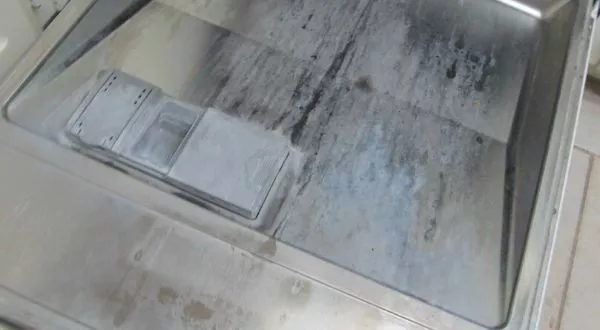
Please remember that not everything is dishwasher safe! If you have any questions about whether or not something can be put in the dishwasher.
It’s always best to ask an expert or check the manual before cleaning.
If there are components inside of your stainless steel appliance such as a filter, you should not put it in the dishwasher.
It’s also important to make sure your drain filter is clean before running your machine.
Otherwise, there is a chance that rust particles could be released into your air and cause damage to the inner workings of an appliance.
How to clean stainless steel pots and pans in the dishwasher?
To properly clean stainless steel pots and pans in the dishwasher, you need to remove any food residue that might be stuck on them.
Make sure there is nothing dirty on the surface before running your machine.
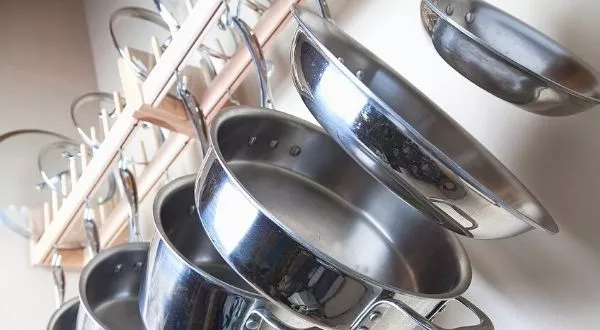
If you’re not sure about your metal, test a small section of it first before cleaning the entire thing. It’s better to be safe than sorry.
If your pans have a protective coating, you should remove them before cleaning. After that, simply place them on the top rack of your dishwasher and let the machine do all of the work for you.
Just remember to pre-rinse off any food residue beforehand so that it doesn’t stick to the surface during the cleaning cycle.
How to clean stainless steel flatware in the dishwasher? Step by Step Guide
To clean stainless steel flatware you have to follow these steps:
1. First of all, you should remove any stubborn food residue using a dishcloth or sponge.
2. Then, you should fill the sink with hot water, add some liquid dish soap and let your flatware soak for about 15 minutes.
3. After this period, use an old toothbrush having soft bristles to get rid of any dried soap scum or stains.
4. Rinse your flatware well under tap water and dry it immediately with a clean towel. Don’t forget to dry the blade because this is where germs tend to hide!
5. Your flatware is ready to be stored in its place after all these steps are successfully completed. But remember stainless steel has a low tolerance to acidic and alkaline food. Therefore, you should avoid any contact with acidic or alkaline foods such as vinegar and lemon juice if possible.
How to clean stainless steel water bottles in the dishwasher?
To properly clean a stainless steel water bottle in the dishwasher, remove any food residue that might be stuck to it. If you’re not sure about your metal, test a small section of it first before cleaning the entire thing.
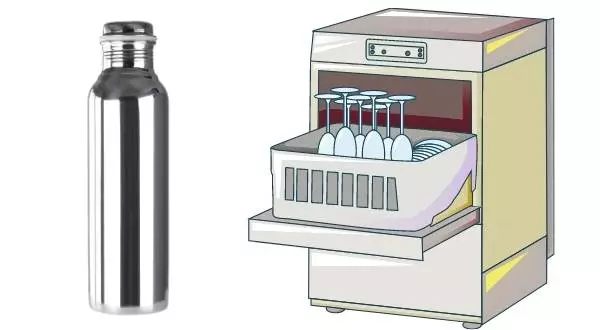
It’s better to be safe than sorry. If there are components on the inside of your bottle such as a filter, you should not put it in the dishwasher.
It’s also important to make sure your drain filter is clean before running your machine.
Otherwise, there is a chance rust particle could get released into your air and cause damage to an appliance or injure someone. How do you keep rust from forming on stainless steel appliances?
There are a few precautions you can take if you want to avoid rust on your stainless steel appliances, or just the kitchen sink.
Follow these simple guidelines to keep the rust off of your appliances:
- Rinse all food residue from surfaces before putting them in the dishwasher
- Don’t use salt water to clean your appliances
- Use coasters underneath glasses and cups
- Remove or replace protective coatings on appliances
- Clean under any protective caps
- Keep the filters in appliances clean
- Remember that not everything is dishwasher safe
- Do not put sterling silver flatware in a dishwasher
How to clean stainless steel sippy cups in the dishwasher?
To clean stainless steel sippy cup you have to follow these steps:
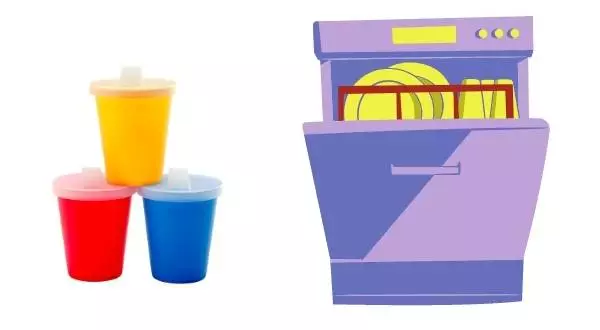
1. First of all, you should remove any stubborn food residue using a dishcloth or sponge.
2. Then, you should fill the sink with hot water and add some liquid dish soap to it. Also, add in 1/4 cup baking soda for tougher stains and let your cups soak for about 15 minutes.
3. After this period use an old toothbrush having soft bristles to get rid of any dried soap scum or stains.
4 . Rinse your sippy cups well under tap water and dry them immediately with a clean towel. Don’t forget to dry the straw because this is where germs tend to hide!
5 . Your sippy cups are ready to be stored in their place after all these steps are successfully completed. But remember stainless steel has a low tolerance to acidic and alkaline food. Therefore, you should avoid any contact with acidic or alkaline foods such as vinegar and lemon juice if possible.
How should I rinse my dishes before putting them in the dishwasher?
You should always rinse your dishes before putting them in the dishwasher. It is a good idea to do this with each load as well as when you first set up your machine.
By rinsing plates, pans, and utensils before placing them into the dishwasher you allow for better cleanings and limited residue on these items, which makes it easier to clean by hand after they have been through the washer.
How to clean stainless steel baby bottles in the dishwasher?
1. Unscrew the nipple from the ring and remove any residual milk from inside using a bottle brush or a pipe cleaner.
Do not use a dishwasher detergent tablet for this step as it can be harmful to your baby’s health if ingested.
2. Put all items in a mesh bag and place them on the top rack of the dishwasher, making sure that none of the parts touch each other during the cleaning cycle to avoid scratching.
NOTE: For additional protection from scratches, you may choose to put a soft cloth between the bottle parts before placing them in the mesh bag. This will also help keep them separate during washing.
3. Use phosphate-free dishwasher detergents only. Generally speaking, solid tablets work better than liquid detergents which may leave a white residue on the items after washing.
NOTE: The use of chlorine bleach in any form is not recommended as it will cause pitting and discoloration over time.
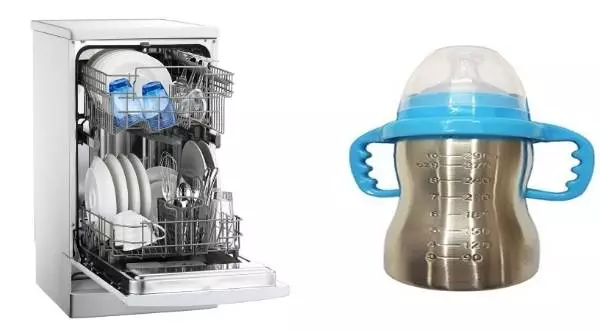
4. Run a Normal cycle without adding any additional rinse aid or salt to avoid spotting. And streaking can occur when these minerals are present in large quantities.
NOTE: If you choose to use vinegar, add one cup of vinegar to the main wash only (first black dot), do not put it in the pre-wash (second black dot) or it will harm your dishwasher’s motor.
5. As with all baby equipment, bottles should be thoroughly air-dried before using them again to avoid bacteria buildup inside.
Since stainless steel is a non-porous material, this will not be an issue as it does not absorb moisture like other materials.
6. Use some type of stainless steel cleaner (e.g., Bar Keepers Friend) if you notice any spots on the surface of the bottles after washing and drying them with a regular powder or liquid dishwasher detergent.
NOTE: For easier cleaning of teats and bottle caps, we recommend using Brush Buddies.
Which are small brushes specifically designed for these purposes. And can be attached to your finger allowing you to deep clean all nooks and crannies without having to use any elbow grease or additional tools. Don’t have one already? You can pick one here.
7. To avoid milk residue buildup, wait for the bottles to cool down before removing them from your dishwasher after cleaning. Milk is a magnet for attracting grease and should be cleaned as soon as possible to avoid unsightly stains on your bottle parts.
NOTE: If you have time, fill up another sink with warm soapy water and clean all baby items by hand immediately after use.
8. The final step in maintaining stainless steel baby bottles is the lubrication of moving parts such as ring connectors or valves. Although not necessary, this can help extend the life of expensive equipment by avoiding rust formation which can cause malfunctions over time.
We recommend using silicone-based products only (e.g., Super Lubricant) because they are food grade safe and will not damage rubber parts.
NOTE: If you plan to keep your bottles for future use with new siblings or children, lubrication will also help prolong their life span and reduce the risk of rusting at connection areas which can cause leaking.
How to clean stainless steel cutlery in the dishwasher?
To properly clean stainless steel cutlery in the dishwasher. First, make sure there is nothing stuck to it. If you’re not sure about your metal, test a small section of it first before cleaning the entire thing.
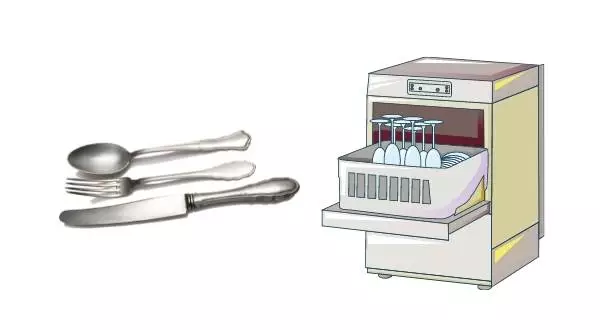
It’s better to be safe than sorry. After that, simply place them on the top rack of your dishwasher and let the machine do all of the work for you.
Just remember to pre-rinse off any food residue beforehand so that it doesn’t get stuck during the cleaning cycle.
FAQs
Can you put stainless steel appliances in the dishwasher?
Some appliances are better suited for dishwashers than others. For example, some top-of-the-line dishwashers have a special setting they can use specifically to clean stainless steel.
But if you don’t have one of those types of dishwashers, make sure you test your metal before cleaning it with soap and water.
Because there’s a chance that the mixture might discolor it or rust parts together.
Can I wash my stainless steel baby dishes in the dishwasher?
Yes, as long as there is nothing stuck to it first! Baby bottles must be pre-rinsed off before being placed into any type of washing machine because they risk getting damaged by water and/or soap.
If you have any concerns about the dishwasher being too hot for your baby’s bottles. Test a small section of it first before cleaning the entire bottle.
Can I wash my stainless steel appliances with soap?
No, stainless steel appliances should not be washed with soap or they can become discolored or rust parts together.
Instead, clean them by using specially formulated products that are meant to remove fingerprints and hand prints from stainless steel surfaces.
Can I wash my stainless steel pot in the dishwasher?
Yes, as long as there is nothing stuck to it first! Make sure you pre-rinse off residues like oil or grease beforehand because this type of food will get cooked onto your stainless steel pot if it isn’t properly rinsed.
Final Words
The bottom line is that most stainless steel can be washed in the dishwasher as long as they’re pre-rinsed.
and if you’re not sure about your metal, test a small section of it first before cleaning the entire thing. It’s better to be safe than sorry.
Remember: If you have a stainless steel dishwasher, the best way to clean your appliances is by using its special cycle settings. If not, simply place them on the top rack of your dishwasher and let the machine do all of the work for you.

